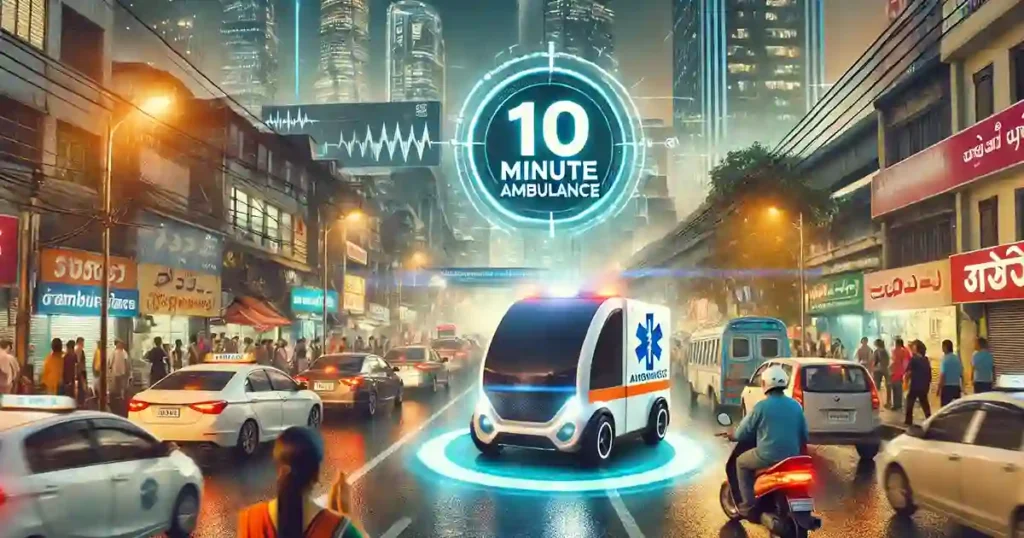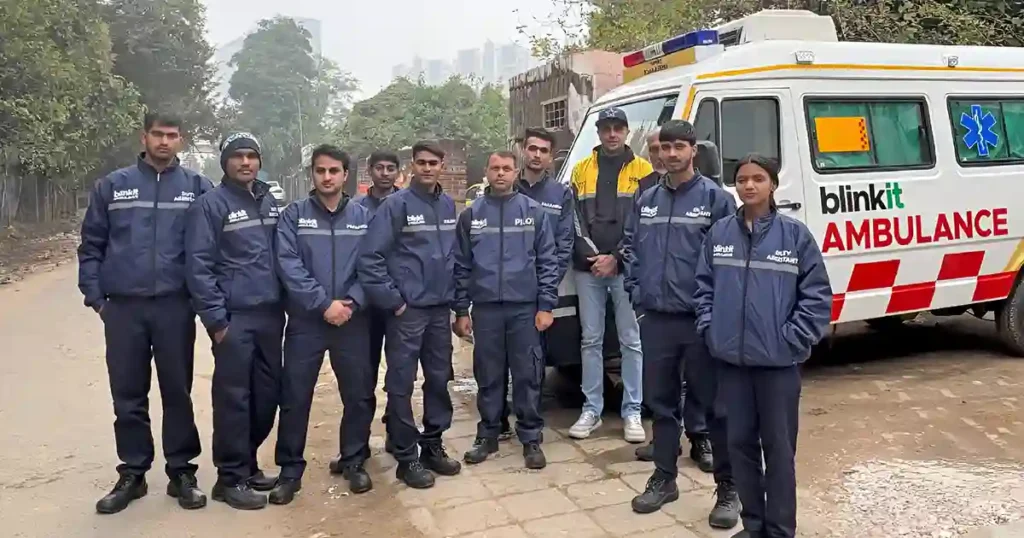The landscape of emergency healthcare in India is undergoing a transformative change with the launch of Blinkit’s groundbreaking 10-minute ambulance service. Known for its rapid grocery deliveries, Blinkit has now entered the healthcare sector with a mission to bridge the gap between medical emergencies and immediate response. This innovative service is a beacon of hope for millions, promising to save countless lives by significantly reducing response times.
In this article, we dive deep into Blinkit’s ambitious new initiative, exploring its operational model, technological backbone, societal impact, and the challenges it seeks to overcome. Let’s examine how Blinkit is setting a new benchmark in emergency healthcare.

The Need for Rapid Response in Medical Emergencies
India’s healthcare system, though vast, often struggles with delayed emergency response times. According to data from the World Health Organization (WHO), the “golden hour” — the critical period immediately following a traumatic injury or medical emergency — is vital for saving lives and preventing long-term complications. Unfortunately, in many Indian cities, ambulances often take 30 minutes or more to arrive due to traffic congestion, limited resources, or infrastructural challenges.
This delay can mean the difference between life and death. Blinkit’s 10-minute ambulance service aims to address this urgent need, offering a lifeline to patients in distress and their families.
How Blinkit’s Ambulance Service Works
Blinkit’s ambulance service leverages its existing hyperlocal delivery model and advanced technology to provide rapid medical assistance. Here’s how the system operates:
1. App Integration
- Users can book an ambulance directly through the Blinkit app, which features a dedicated section for emergency healthcare services.
- The interface is user-friendly, requiring minimal steps to request help, ensuring even first-time users can navigate it during high-stress situations.
2. Geo-Location Technology
- The service uses advanced geo-location and mapping tools to identify the patient’s exact location.
- Nearby ambulances are alerted immediately, minimizing the response time.
3. Strategic Ambulance Placement
- Blinkit has partnered with local hospitals, clinics, and independent ambulance providers to station vehicles strategically across cities.
- These ambulances are equipped with basic life support (BLS) and advanced life support (ALS) systems, catering to diverse medical emergencies.
4. Real-Time Tracking and Communication
- Users can track the ambulance in real-time on the app, similar to Blinkit’s grocery delivery model.
- An in-app chat or call feature connects users with medical professionals for guidance while the ambulance is en route.
Technological Backbone: The Engine Driving the Service
Blinkit’s foray into emergency healthcare wouldn’t be possible without cutting-edge technology. The service employs:
- AI-Powered Algorithms: To predict high-demand zones and optimize ambulance placement.
- IoT Devices: To monitor vehicle status and ensure readiness.
- Data Analytics: For continuous improvement based on user feedback and historical trends.
- Telemedicine Integration: Some ambulances come equipped with telemedicine facilities, allowing patients to consult with doctors en route to the hospital.
Collaborations and Partnerships
To ensure the success of its 10-minute ambulance service, Blinkit has collaborated with key stakeholders:
- Hospitals: For providing trained paramedics and medical equipment.
- State Governments: To streamline operations and comply with local healthcare regulations.
- NGOs and Healthcare Startups: To extend reach into underserved areas.
- Technology Providers: For seamless integration of GPS, AI, and IoT solutions.
Impact on Urban and Rural Healthcare
Urban Areas:
In densely populated cities like Delhi, Mumbai, and Bengaluru, traffic congestion is a significant barrier to timely medical assistance. Blinkit’s model addresses this challenge by:
- Utilizing bike ambulances for narrow streets and heavy traffic zones.
- Deploying smaller, faster vehicles equipped with essential medical tools.
Rural Areas:
Rural India faces a severe shortage of ambulances and medical infrastructure. Blinkit’s service, with its emphasis on strategic placement and telemedicine, can:
- Reduce the time taken to reach remote villages.
- Provide initial medical consultation via telemedicine, bridging the gap until physical help arrives.
Real-Life Scenarios: Stories of Lives Saved
Blinkit’s pilot program, launched in select cities, has already demonstrated its potential. Here are a few examples:
- Cardiac Arrest Case in Delhi: A 55-year-old man experiencing a heart attack received timely CPR and was transported to a hospital within 12 minutes, thanks to Blinkit’s swift response.
- Accident Victim in Bengaluru: A bike ambulance reached a traffic-clogged area in 8 minutes, stabilizing a critically injured individual before transferring them to a trauma center.
- Childbirth in Chennai: A woman in labor safely delivered her baby en route to the hospital with the help of trained paramedics.
Challenges and Limitations
While Blinkit’s initiative is a game-changer, it is not without hurdles:
- Operational Costs: Maintaining a fleet of ambulances and trained staff is expensive.
- Traffic Management: Even with geo-location, navigating congested urban areas remains a challenge.
- Awareness: Educating the public about the service and its availability will require extensive marketing efforts.
- Regulatory Approvals: Complying with healthcare and transportation regulations in various states may slow expansion.
Future Prospects and Expansion Plans
Blinkit’s vision extends beyond its initial rollout. The company plans to:
- Expand to Tier 2 and Tier 3 cities.
- Introduce specialized ambulances for pediatric, neonatal, and trauma care.
- Integrate with government health schemes like Ayushman Bharat for greater affordability.
- Develop a subscription model for frequent users, offering priority access and discounts.
A Revolution in Emergency Healthcare
Blinkit’s 10-minute ambulance service is more than just a business venture; it’s a societal revolution. By prioritizing speed, technology, and accessibility, Blinkit is setting a precedent for private companies to play a pivotal role in public welfare.
Conclusion: A Step Toward a Healthier India
In a country where emergency response times often fall short, Blinkit’s initiative is a ray of hope. Its ability to adapt a proven delivery model to healthcare underscores the power of innovation in addressing critical challenges. While hurdles remain, the potential to save lives and transform emergency care makes this a landmark step in India’s healthcare journey.
As Blinkit’s ambulances zip through cities in record time, they symbolize not just speed but a commitment to life, compassion, and progress. For millions of Indians, this service might just be the difference between despair and a second chance at life.






